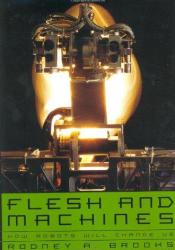Rodney Brooks, Flesh and Machines (2002)
Rodney Brooks, Flesh and Machines: How Robots Will Change Us, 2002.
Synopsis:
Brooks substantiates his hypothesis by relating his own professional experiences in his robotics lab at MIT. His vision for robotic functionality was driven by a desire to emulate the sinister HAL 9000 from Kubrick's 2001 A Space Odyssey (1968). Disappointed by the lack of general intelligence (being able to walk into a room or navigate over obstacles) displayed by the robots of his industry peers, Brooks set out to approach the entire question of robotics differently. His working method centered around identifying the key operating assumption everyone else took for granted and then refuting it! This way of thinking led Brooks to pioneer his sensation-action theory of intelligence -- bypassing explicit cognition hubs in favor of pairing perception more directly with action. He was inspired by insects who, he noted, have much less powerful brains than his computer processors, yet amazing functionality. This line of thought led him to great Genghis, and later a fascination with sight and aural perception led him to lead the creation of Kismet. Throughout his career, Brooks was often mocked by peers and potential business partners for his then-outlandish theories of machine intelligence. Since then, however, his research has created space for increased industry-wide consideration of both the sensation-action model and the importance of generalized intelligence in the development of AI.
Topics: In class, we read Chapter Three: "Planetary Ambassadors" and Chapter Four: "It's 2001 Already".
Throughout Chapter 3, Brooks highlights the creation of the Genghis robot -- a six-legged insect-like robot that can navigate towards a human body while maneuvering over considerable obstacles in its path. Genghis was the result of Brooks' experimentation with linking sensation and action more directly. Looking to insects as inspiration, Brooks created Genghis by removing any cognition processors and left only its sensors (sensation) and the code/hardware to allow it to walk. This allowed Genghis to have an unprecedented connection between perception of environment and action. When Genghis walks, it does not plan out its path ahead of time. It simply relies on a constant relationship between perception and immediate response action. In other words, Genghis senses a target via heat sensor. It then moves in that direction, dealing with obstacles or changes in trajectory as necessary. Chapter 3 also talks about Brooks' theory of layered processing. To achieve greater functionality with less processing power, Brooks innovated a method of machine thought that relied on hierarchized layers of imperatives, reminiscent to him of the progression of evolution and the layering of new traits over older ones. So for example, a robot might have three processing layers. The first may be to avoid bumping into obstacles. The second may be to walk, then the third may be to have a sort of wanderlust by which it is constantly exploring new things. The practical result of this method is a robot that can quickly walk through a fluid environment. On a processing level, however, the complexity of each of the three facets of the final movement are addressed separately by each layer, reducing the burden of complex processing from the processors at each level. To read more about this, check out my blog post on the connection between Brooks' layered processing and the working method of the Surrealists: Subverting Cognition: Surrealist Automatism and Brooks' Intelligence Theory.
Chapter 4 discusses Brooks' lab's desire to create a robot that progressed beyond simply walking; they wanted to make a robot that could somehow interact and communicate with humans. To do this, Brooks and his colleagues once again thought out of the box. Instead of making a robot that could actually process language, they focused more on the discernment of vocal tone, inflection, and facial expressions. Enter Kismet. Brooks and his team designed Kismet, a robot designed to look like a strange head, with enormous eyes, ears, and a mouth. Though Kismet cannot actually understand or speak human language, Kismet's processors can extrapolate moods from the way that people talk
About Brooks:
Brooks is an innovator, writer, a robotics entrepreneur, and visionary. He is the Founder, Chairman and CTO of Rethink Robotics. He is also a Founder, former Board Member (1990 - 2011) and former CTO (1990 - 2008) of iRobot Corp (Nasdaq: IRBT). Dr. Brooks is the former Director of the MIT Artificial Intelligence Laboratory, a position he held from (1997-2007) He studied at Flinders University of South Australia and earned his Ph.D. in Computer Science from Stanford in 1981. He held research positions at Carnegie Mellon University and MIT, and a faculty position at Stanford before joining the faculty of MIT in 1984. He has published many papers in computer vision, artificial intelligence, robotics, and artificial life.
Sources:
https://people.csail.mit.edu/brooks/_
Flesh and Machines: How Robots Will Change Us (2002)
To Learn More about Brooks' projects -- Genghis and Kismet -- check out these videos:

